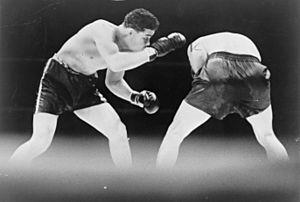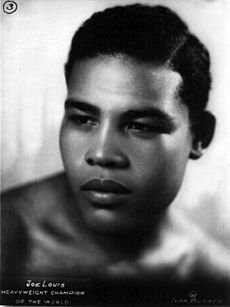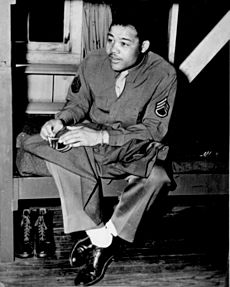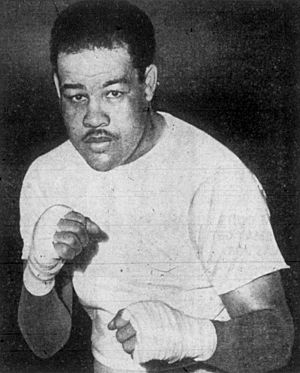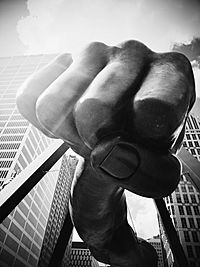Joe Louis facts for kids
Quick facts for kids Joe Louis |
|||||||||||||||||||||||
|---|---|---|---|---|---|---|---|---|---|---|---|---|---|---|---|---|---|---|---|---|---|---|---|
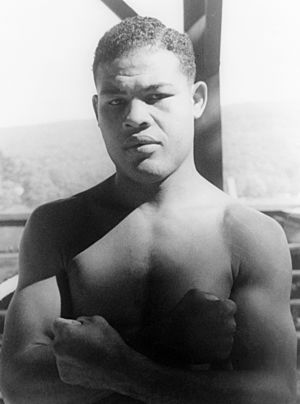
Joe Louis in September 1941
|
|||||||||||||||||||||||
| Statistics | |||||||||||||||||||||||
| Real name | Joseph Louis Barrow | ||||||||||||||||||||||
| Nickname(s) | Brown Bomber | ||||||||||||||||||||||
| Rated at | Heavyweight | ||||||||||||||||||||||
| Height | 6 ft 1+1/2 in | ||||||||||||||||||||||
| Reach | 76 in | ||||||||||||||||||||||
| Born | May 13, 1914 LaFayette, Alabama, U.S. |
||||||||||||||||||||||
| Died | April 12, 1981 (aged 66) Paradise, Nevada, U.S. |
||||||||||||||||||||||
| Stance | Orthodox | ||||||||||||||||||||||
| Boxing record | |||||||||||||||||||||||
| Total fights | 69 | ||||||||||||||||||||||
| Wins | 66 | ||||||||||||||||||||||
| Wins by KO | 52 | ||||||||||||||||||||||
| Losses | 3 | ||||||||||||||||||||||
|
Medal record
|
|||||||||||||||||||||||
Joseph Louis Barrow (May 13, 1914 – April 12, 1981) was an American professional boxer who competed from 1934 to 1951. He was nicknamed the Brown Bomber and had the longest single reign as champion of any boxer in history: from 1937 to 1949.
Contents
Early life
Joe Louis was born May 13, 1914, in rural Chambers County, Alabama. He was the seventh of eight children of Munroe Barrow and Lillie (Reese) Barrow. Both of his parents were children of former slaves. Munroe was an African American with some European ancestry, while Lillie was half Cherokee.
Because of a speech impediment, Joe did not speak much until he was about six. He knew very little of his father, who was committed to a mental institution in 1916. Around 1920, after receiving word that Joes's father had passed away, Louis's mother married Pat Brooks, a local construction contractor.
In 1926, Louis's family moved to Detroit, Michigan. The were part of the post-World War I Great Migration. Joe's brother, and later Joe, worked for Ford Motor Company while living there. He also went to Bronson Vocational School to learn cabinet-making.
Amateur career
The Great Depression hit the Barrow family hard, but Joe still made time to exercise at a local youth recreation center at 637 Brewster Street in Detroit. His mother tried to get him to play the violin, but he liked boxing better.
Louis made his debut in early 1932 at the age of 17. He lost that first fight, but won many other fights. Eventually, he won the club championship of his Brewster Street recreation center, the home of many aspiring Golden Gloves fighters. By the end of his amateur career, Louis's record was 50–4, with 43 knockouts.
Professional career
Joe Louis had only three losses in his 69 professional fights. 52 of his wins were knockouts. He held the title of champion from 1937 until he retired in 1949. He returned from retirement and regained the championship in 1950, but his boxing career ended after he was knocked out by Rocky Marciano in 1951.
Early years
Professional promoters were impressed with Joe Louis's amateur career. A black Detroit-area bookmaker named John Roxborough partnered with Julian Black to become Joe Louis's managers. Black hired Jack "Chappie" Blackburn as Louis's trainer. His first professional fight was on July 4, 1934, in which he defeated Jack Kracken and won $59.00 ($1,291 in 2025 dollars ).
Black and Roxborough continued to carefully and deliberately shape Louis's the way the media, and therefore the public, would view him. Another black boxer who was champion of the heavyweight division, Jack Johnson, was not popular among white people. Black and Roxborough did not want Louis to appear too similar to Johnson, so they wrote "Seven Commandments" for Louis's conduct that would show his modesty and sportsmanship. These included:
- Never have his picture taken with a white woman.
- Never gloat over a fallen opponent.
- Never engage in fixed fights.
- Live and fight clean.
As a result, Louis was shown in the white media as a modest, clean-living person. This helped him become a popular fighter.
Louis fought thirteen times in 1935. The bout (fight) that drew the attention of the media happened on June 25, when Louis knocked out 6'6," 265-pound former world heavyweight champion Primo Carnera in six rounds. Canera represented Benito Mussolini's Italy, which brought politics into sports. African Americans, who were sympathetic to Ethiopia, which was attempting to maintain its independence by fending off an invasion by fascist Italy were glad when Louis won the fight.
Other fights that brought attention to Louis were his fight against former titleholder Max Baer and Paolino Uzcudun. Baer had only been knocked out once before, and Uzcudun had never been knocked out.
Louis vs. Schmeling I
By this time, Louis was ranked as the No. 1 contender in the heavyweight division. He had won the "Athlete of the Year" Award for 1935. He was scheduled for one final fight before a title shot against the German Max Schmeling, who had been knocked out by the same Max Baer Louis had beaten. Louis and his team did not consider Schmeling much of a threat, so Louis spent time on the golf course rather than training intensely for the match. However, Schmeling prepared intently for the bout and knocked Louis out in round 12 at Yankee Stadium on June 19, 1936. The event would lead to their historic rematch in one of the world's most famous sporting events.
World championship
After defeating Louis, Schmeling expected a title shot against James J. Braddock, who had unexpectedly defeated Max Baer for the heavyweight title the previous June. However, after a series of deals and legal battles, Braddock was set to fight Louis for the heavyweight champion title. On the night of the fight, June 22, 1937, Braddock was able to knock Louis down in round one, but Louis did well for the rest of the fight and knocked Braddock out in the eighth round. It was the first time Braddock had been knocked out in his career. This gave Louis the title of heavyweight champion of the world.
Despite his championship, Louis did not want to be called champ until he defeated Max Schmeling. Louis's manager Mike Jacobs tried to schedule a rematch in 1937, but negotiations broke down. Louis went on to fight British Empire champion Tommy Farr, Nathan Mann, and Harry Thomas. He defeated all three. Finally, a rematch was scheduled with Schmeling for June 1938.
Louis vs. Schmeling II
The rematch between Louis and Schmeling would become one of the most famous boxing matches of all time. Max had become a national hero in Germany for defeating an African American. Nazi officials said that this was proof of their doctrine of Aryan superiority.
On the night of June 22, 1938, Louis and Schmeling met for the second time in the boxing ring. Radio announcers reported on the fight in English, German, Spanish, and Portuguese. It was the first time that many white Americans openly cheered for a black man against a white opponent.
The fight lasted two minutes and four seconds. Schmeling only managed to throw two punches in the entire bout. Louis knocked him down three times. On the third knockdown, Schmeling's trainer threw in the towel and referee Arthur Donovan stopped the fight.
World War II
Louis fought a charity bout for the Navy Relief Society against his former opponent Buddy Baer on January 9, 1942, which raised $47,000 for the fund. The next day, he volunteered to enlist as a private in the United States Army at Camp Upton, Long Island. He fought another charity bout against Abe Simon on March 27, 1942, which raised $36,146. Although Louis never took any of the money for these and other charitable fights, the IRS said that he did and taxed him for it.
For basic training, Louis was assigned to a segregated cavalry unit based in Fort Riley, Kansas. He met UCLA athletic legend Jackie Robinson at Officer Candidate School (OCS), and the two became friends.
The Army placed him in its Special Services Division rather than sending him into combat. He traveled more than 35,000 km (22,000 mi) and entertained more than two million soldiers by fighting in 96 boxing matches.
The media used Louis to encourage African-American men to enlist in the Armed Services. The publicity of the campaign made Louis popular in the U.S., even outside the world of sports. Never before had white Americans embraced a black man as their representative to the world.
After he was promoted to the rank of technical sergeant, he was awarded the Legion of Merit for "incalculable contribution to the general morale." This qualified him to be released from the military on October 1, 1945.
Later career and retirement
After his wartime service, Louis was faced with his tax bill from the IRS, and his former manager, boxing promoter Mike Jacobs, claimed that Louis owed him $250,000. Louis did not get most of the money he made from his fights. Much of it went to his managers. Louis knew he needed to fight again to make money. He fought and won two fights before announcing his retirement from boxing on March 1, 1949. He did fight in exhibition fights during his retirement.
Post-retirement comeback
At the time of Louis's first retirement, the IRS was still completing its investigation of his prior tax returns. In May 1950, the IRS told Louis that he owed the government more than $500,000. Louis had no choice but to return to the ring.
Louis found a new manager, Marshall Miles, and worked out a deal with the IRS: The money Louis made from fighting would go to the IRS. Louis, who was not the fighter he used to be, did not fight well and was forced to retire again after he was defeated by Rocky Marciano on October 26, 1951.
Taxes and financial troubles
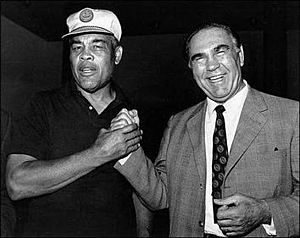
Louis still owed the government money and paid as much as he could. He invested in several businesses that failed, so friends - including his former rival Max Schmeling - helped him financially.
Professional golf
One of Louis's other passions was the game of golf, in which he also played a historic role. When Louis was invited to play a PGA Tour event, the PGA of America had a bylaw that stated only "Caucasians" were allowed to be members of the Association. Louis's celebrity status made them reconsider, and they changed the bylaw in November 1961.
He also helped found The First Tee, a charity helping underprivileged children learn the game of golf. His son, Joe Louis Barrow, Jr., currently oversees the organization.
Personal life and death
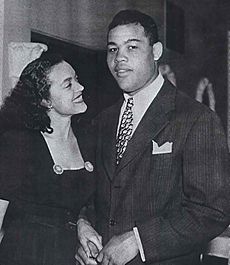
Louis had two children with his first wife, a journalist named Marva Trotter (daughter Jacqueline in 1943 and son Joseph Louis Barrow Jr. in 1947). They divorced in March 1945, remarried in 1946, and divorced again in 1949.
Louis married Rose Morgan, a successful Harlem businesswoman, in 1955. Their marriage was annulled in 1958.
Louis's final marriage—to Martha Jefferson, a lawyer from Los Angeles, on St. Patrick's Day 1959—lasted until his death. They had four children: another son named Joseph Louis Barrow Jr, John Louis Barrow, Joyce Louis Barrow, and Janet Louis Barrow. The younger Joe Louis Barrow Jr. lives in New York City and is involved in boxing.
In 1969, he was hospitalized after collapsing on a New York City street. In 1970, his wife Martha and son, Joe Louis Barrow, Jr., placed Louis at the Colorado Psychiatric Hospital and the Veterans Administration Hospital in Denver for paranoia. He continued to suffer strokes and heart ailments.
Louis died of cardiac arrest in Desert Springs Hospital near Las Vegas on April 12, 1981. Max Schmeling paid for part of his funeral and was a pallbearer (someone who helps other people carry a casket). Louis was buried in Arlington National Cemetery with full military honors on April 21, 1981.
Film and television
Louis appeared in six full-length films and two short films. He starred as himself in four of the films. He appeared on the television show You Bet Your Life in 1955.
Legacy
Louis is thought of as one of the greatest boxers of all time. He reigned as the world heavyweight champion from 1937 to 1949. Louis has won 26 world heavyweight title fights in history, the most in history. He was named Fighter of the Year four times by The Ring magazine in 1936, 1938, 1939, and 1941.
On February 27, 2010, an 8-foot (2.4 m) bronze statue of Louis was unveiled in his Alabama hometown. The statue, by sculptor Casey Downing, Jr., sits on a base of red granite outside the Chambers County Courthouse.
In 1993, he became the first boxer to be honored on a postage stamp issued by the U.S. Postal Service.
Other monuments, facilities, and even sports teams have been named after him. New York Post sportswriter Jimmy Cannon, when responding to another person's characterization of Louis as "a credit to his race," stated, "Yes, Joe Louis is a credit to his race — the human race."
Joe Louis quotes
- "Everyone has a plan until they've been hit."
- "He can run, but he can't hide"
- "I did the best I could with what I had."
- "Lots of things wrong with America, but Hitler ain't going to fix them."
- "This country has been good to me. It gave me everything I have."
Interesting facts about Joe Louis
- Joe weighed 11 pounds (5 kg) at birth.
- His real name was Joe Louis Barrow.
- Growing up, Louis and his seven siblings often slept three and four to a bed.
- There are two stories about why Joe Louis Barrow was known as Joe Louis:
- He wrote his name so large when signing a paper before a fight that there was no room for his last name.
- He purposely did not write his last name to hide his boxing from his mother.
- As a professional boxer, he won his first 27 fights. In 23 of them, he knocked out his opponent.
- Louis was the heavyweight champion of the world for 11 years and 8 months, longer than anyone else in the 20th century.
- Of his 69 professional fights, Joe Louis only lost 3.
- Louis retired from boxing at age 35.
Professional boxing record
| 69 fights | 66 wins | 3 losses |
| By knockout | 52 | 2 |
| By decision | 13 | 1 |
| By disqualification | 1 | 0 |
| No. | Result | Record | Opponent | Type | Round, time | Date | Age | Location | Notes |
|---|---|---|---|---|---|---|---|---|---|
| 69 | Loss | 66–3 | Rocky Marciano | TKO | 8 (10) | Oct 26, 1951 | 37 years, 166 days | Madison Square Garden, New York City, New York, U.S. | |
| 68 | Win | 66–2 | Jimmy Bivins | UD | 10 | Aug 15, 1951 | 37 years, 94 days | Memorial Stadium, Baltimore, Maryland, U.S. | |
| 67 | Win | 65–2 | Cesar Brion | UD | 10 | Aug 1, 1951 | 37 years, 80 days | Cow Palace, Daly City, California, U.S. | |
| 66 | Win | 64–2 | Lee Savold | KO | 6 (15), 2:29 | Jun 15, 1951 | 37 years, 33 days | Madison Square Garden, New York City, New York, U.S. | |
| 65 | Win | 63–2 | Omelio Agramonte | UD | 10 | May 2, 1951 | 36 years, 354 days | Olympia, Detroit, Michigan, U.S. | |
| 64 | Win | 62–2 | Andy Walker | TKO | 10 (10), 1:49 | Feb 23, 1951 | 36 years, 286 days | Cow Palace, Daly City, California, U.S. | |
| 63 | Win | 61–2 | Omelio Agramonte | UD | 10 | Feb 7, 1951 | 36 years, 270 days | Miami Stadium, Miami, Florida, U.S. | |
| 62 | Win | 60–2 | Freddie Beshore | TKO | 4 (10), 2:48 | Jan 3, 1951 | 36 years, 235 days | Olympia, Detroit, Michigan, U.S. | |
| 61 | Win | 59–2 | Cesar Brion | UD | 10 | Nov 29, 1950 | 36 years, 200 days | Chicago Stadium, Chicago, Illinois, U.S. | |
| 60 | Loss | 58–2 | Ezzard Charles | UD | 15 | Sep 27, 1950 | 36 years, 137 days | Yankee Stadium, New York City, New York, U.S. | For NBA, vacant NYSAC, and The Ring heavyweight titles |
| 59 | Win | 58–1 | Jersey Joe Walcott | KO | 11 (15) | Jun 25, 1948 | 34 years, 43 days | Yankee Stadium, New York City, New York, U.S. | Retained NYSAC, NBA, and The Ring heavyweight titles |
| 58 | Win | 57–1 | Jersey Joe Walcott | SD | 15 | Dec 5, 1947 | 33 years, 206 days | Madison Square Garden, New York City, New York, U.S. | Retained NYSAC, NBA, and The Ring heavyweight titles |
| 57 | Win | 56–1 | Tami Mauriello | KO | 1 (15), 2:09 | Sep 18, 1946 | 32 years, 128 days | Yankee Stadium, New York City, New York, U.S. | Retained NYSAC, NBA, and The Ring heavyweight titles |
| 56 | Win | 55–1 | Billy Conn | KO | 8 (15), 2:19 | Jun 19, 1946 | 32 years, 37 days | Yankee Stadium, New York City, New York, U.S. | Retained NYSAC, NBA, and The Ring heavyweight titles |
| 55 | Win | 54–1 | Johnny Davis | TKO | 1 (4), 0:53 | Nov 14, 1944 | 30 years, 185 days | Memorial Auditorium, Buffalo, New York, U.S. | Retained NYSAC and The Ring heavyweight titles |
| 54 | Win | 53–1 | Abe Simon | TKO | 6 (15), 0:16 | Mar 27, 1942 | 27 years, 318 days | Madison Square Garden, New York City, New York, U.S. | Retained NYSAC, NBA, and The Ring heavyweight titles |
| 53 | Win | 52–1 | Buddy Baer | KO | 1 (15), 2:56 | Jan 9, 1942 | 27 years, 241 days | Madison Square Garden, New York City, New York, U.S. | Retained NYSAC, NBA, and The Ring heavyweight titles |
| 52 | Win | 51–1 | Lou Nova | TKO | 6 (15), 2:59 | Sep 29, 1941 | 27 years, 139 days | Polo Grounds, New York City, New York, U.S. | Retained NYSAC, NBA, and The Ring heavyweight titles |
| 51 | Win | 50–1 | Billy Conn | KO | 13 (15), 2:58 | Jun 18, 1941 | 27 years, 36 days | Polo Grounds, New York City, New York, U.S. | Retained NYSAC, NBA, and The Ring heavyweight titles |
| 50 | Win | 49–1 | Buddy Baer | DQ | 7 (15), 3:00 | May 23, 1941 | 27 years, 10 days | Griffith Stadium, Washington, D.C., U.S. | Retained NYSAC, NBA, and The Ring heavyweight titles; Baer disqualified after his manager refused to leave the ring |
| 49 | Win | 48–1 | Tony Musto | TKO | 9 (15), 1:36 | Apr 8, 1941 | 26 years, 330 days | St. Louis Arena, St. Louis, Missouri, U.S. | Retained NYSAC, NBA, and The Ring heavyweight titles |
| 48 | Win | 47–1 | Abe Simon | TKO | 13 (20), 1:20 | Mar 21, 1941 | 26 years, 312 days | Olympia, Detroit, Michigan, U.S. | Retained NYSAC, NBA, and The Ring heavyweight titles |
| 47 | Win | 46–1 | Gus Dorazio | KO | 2 (15), 1:30 | Feb 17, 1941 | 26 years, 280 days | Convention Hall, Philadelphia, Pennsylvania, U.S. | Retained NYSAC, NBA, and The Ring heavyweight titles |
| 46 | Win | 45–1 | Red Burman | KO | 5 (15), 2:49 | Jan 31, 1941 | 26 years, 263 days | Madison Square Garden, New York City, New York, U.S. | Retained NYSAC, NBA, and The Ring heavyweight titles |
| 45 | Win | 44–1 | Al McCoy | RTD | 5 (15), 3:00 | Dec 16, 1940 | 26 years, 217 days | Boston Garden, Boston, Massachusetts, U.S. | Retained NYSAC, NBA, and The Ring heavyweight titles |
| 44 | Win | 43–1 | Arturo Godoy | TKO | 8 (15), 1:24 | Jun 20, 1940 | 26 years, 38 days | Yankee Stadium, New York City, New York, U.S. | Retained NYSAC, NBA, and The Ring heavyweight titles |
| 43 | Win | 42–1 | Johnny Paychek | TKO | 2 (15), 0:41 | Mar 29, 1940 | 25 years, 321 days | Madison Square Garden, New York City, New York, U.S. | Retained NYSAC, NBA, and The Ring heavyweight titles |
| 42 | Win | 41–1 | Arturo Godoy | SD | 15 | Feb 9, 1940 | 25 years, 272 days | Madison Square Garden, New York City, New York, U.S. | Retained NYSAC, NBA, and The Ring heavyweight titles |
| 41 | Win | 40–1 | Bob Pastor | KO | 11 (20), 0:38 | Sep 20, 1939 | 25 years, 130 days | Briggs Stadium, Detroit, Michigan, U.S. | Retained NYSAC, NBA, and The Ring heavyweight titles |
| 40 | Win | 39–1 | Tony Galento | TKO | 4 (15), 2:29 | Jun 28, 1939 | 25 years, 46 days | Yankee Stadium, New York City, New York, U.S. | Retained NYSAC, NBA, and The Ring heavyweight titles |
| 39 | Win | 38–1 | Jack Roper | KO | 1 (10), 2:20 | Apr 17, 1939 | 24 years, 339 days | Wrigley Field, Los Angeles, California, U.S. | Retained NYSAC, NBA, and The Ring heavyweight titles |
| 38 | Win | 37–1 | John Henry Lewis | KO | 1 (15), 2:29 | Jan 25, 1939 | 24 years, 257 days | Madison Square Garden, New York City, New York, U.S. | Retained NYSAC, NBA, and The Ring heavyweight titles |
| 37 | Win | 36–1 | Max Schmeling | KO | 1 (15), 2:04 | Jun 22, 1938 | 24 years, 40 days | Yankee Stadium, New York City, New York, U.S. | Retained NYSAC, NBA, and The Ring heavyweight titles |
| 36 | Win | 35–1 | Harry Thomas | KO | 5 (15), 2:50 | Apr 4, 1938 | 23 years, 326 days | Chicago Stadium, Chicago, Illinois, U.S. | Retained NBA and The Ring heavyweight titles |
| 35 | Win | 34–1 | Nathan Mann | KO | 3 (15), 1:36 | Feb 23, 1938 | 23 years, 314 days | Madison Square Garden, New York City, New York, U.S. | Retained NYSAC, NBA, and The Ring heavyweight titles |
| 34 | Win | 33–1 | Tommy Farr | UD | 15 | Aug 30, 1937 | 23 years, 109 days | Yankee Stadium, New York City, New York, U.S. | Retained NYSAC and The Ring heavyweight titles |
| 33 | Win | 32–1 | James J. Braddock | KO | 8 (15) | Jun 22, 1937 | 23 years, 40 days | Comiskey Park, Chicago, Illinois, U.S. | Won NYSAC, NBA, and The Ring heavyweight titles |
| 32 | Win | 31–1 | Natie Brown | KO | 4 (10), 0:52 | Feb 17, 1937 | 22 years, 280 days | Municipal Auditorium, Kansas City, Missouri, U.S. | |
| 31 | Win | 30–1 | Bob Pastor | UD | 10 | Jan 29, 1937 | 22 years, 261 days | Madison Square Garden, New York City, New York, U.S. | |
| 30 | Win | 29–1 | Steve Ketchel | KO | 2 (4), 0:31 | Jan 11, 1937 | 22 years, 243 days | Broadway Auditorium, Buffalo, New York, U.S. | |
| 29 | Win | 28–1 | Eddie Simms | TKO | 1 (10), 0:26 | Dec 14, 1936 | 22 years, 215 days | Public Auditorium, Cleveland, Ohio, U.S. | |
| 28 | Win | 27–1 | Jorge Brescia | KO | 3 (10), 2:12 | Oct 9, 1936 | 22 years, 149 days | Hippodrome Theatre, New York City, New York, U.S. | |
| 27 | Win | 26–1 | Al Ettore | KO | 5 (15), 1:28 | Sep 22, 1936 | 22 years, 132 days | Municipal Stadium, Philadelphia, Pennsylvania, U.S. | |
| 26 | Win | 25–1 | Jack Sharkey | KO | 3 (10), 1:02 | Aug 18, 1936 | 22 years, 97 days | Yankee Stadium, New York City, New York, U.S. | |
| 25 | Loss | 24–1 | Max Schmeling | KO | 12 (15), 2:29 | Jun 19, 1936 | 22 years, 37 days | Yankee Stadium, New York City, New York, U.S. | |
| 24 | Win | 24–0 | Charley Retzlaff | KO | 1 (15), 1:25 | Jan 17, 1936 | 21 years, 249 days | Chicago Stadium, Chicago, Illinois, U.S. | |
| 23 | Win | 23–0 | Paulino Uzcudun | TKO | 4 (15), 2:32 | Dec 13, 1935 | 21 years, 214 days | Madison Square Garden, New York City, New York, U.S. | |
| 22 | Win | 22–0 | Max Baer | KO | 4 (15), 3:09 | Sep 24, 1935 | 21 years, 134 days | Yankee Stadium, New York City, New York, U.S. | |
| 21 | Win | 21–0 | King Levinsky | TKO | 1 (10), 2:21 | Aug 7, 1935 | 21 years, 86 days | Comiskey Park, Chicago, Illinois, U.S. | |
| 20 | Win | 20–0 | Primo Carnera | TKO | 6 (15), 2:32 | Jun 25, 1935 | 21 years, 43 days | Yankee Stadium, New York City, New York, U.S. | |
| 19 | Win | 19–0 | Biff Bennett | KO | 1 (6), 1:15 | Apr 22, 1935 | 20 years, 344 days | Memorial Hall, Dayton, Ohio, U.S. | |
| 18 | Win | 18–0 | Roy Lazer | KO | 3 (10), 2:28 | Apr 12, 1935 | 20 years, 334 days | Chicago Stadium, Chicago, Illinois, U.S. | |
| 17 | Win | 17–0 | Natie Brown | UD | 10 | Mar 29, 1935 | 20 years, 320 days | Olympia, Detroit, Michigan, U.S. | |
| 16 | Win | 16–0 | Don "Red" Barry | TKO | 3 (10), 1:30 | Mar 8, 1935 | 20 years, 299 days | New Dreamland Auditorium, San Francisco, California, U.S. | |
| 15 | Win | 15–0 | Lee Ramage | TKO | 2 (10), 2:11 | Feb 21, 1935 | 20 years, 284 days | Wrigley Field, Los Angeles, California, U.S. | |
| 14 | Win | 14–0 | Hans Birkie | TKO | 10 (10), 1:47 | Jan 11, 1935 | 20 years, 243 days | Duquesne Gardens, Pittsburgh, Pennsylvania, U.S. | |
| 13 | Win | 13–0 | Patsy Perroni | PTS | 10 | Jan 4, 1935 | 20 years, 236 days | Olympia, Detroit, Michigan, U.S. | |
| 12 | Win | 12–0 | Lee Ramage | TKO | 8 (10), 2:51 | Dec 14, 1934 | 20 years, 215 days | Chicago Stadium, Chicago, Illinois, U.S. | |
| 11 | Win | 11–0 | Charley Massera | KO | 3 (10), 2:41 | Nov 30, 1934 | 20 years, 201 days | Coliseum, Chicago, Illinois, U.S. | |
| 10 | Win | 10–0 | Stanley Poreda | KO | 1 (10), 2:40 | Nov 14, 1934 | 20 years, 185 days | Arcadia Gardens, Chicago, Illinois, U.S. | |
| 9 | Win | 9–0 | Jack O'Dowd | KO | 2 (10) | Oct 31, 1934 | 20 years, 171 days | Arcadia Gardens, Chicago, Illinois, U.S. | |
| 8 | Win | 8–0 | Art Sykes | KO | 8 (10) | Oct 24, 1934 | 20 years, 164 days | Arcadia Gardens, Chicago, Illinois, U.S. | |
| 7 | Win | 7–0 | Adolph Wiater | PTS | 10 | Sep 26, 1934 | 20 years, 136 days | Arcadia Gardens, Chicago, Illinois, U.S. | |
| 6 | Win | 6–0 | Al Delaney | TKO | 4 (10) | Sep 11, 1934 | 20 years, 121 days | Naval Armory, Detroit, Michigan, U.S. | |
| 5 | Win | 5–0 | Buck Everett | KO | 2 (8) | Aug 27, 1934 | 20 years, 106 days | Marigold Gardens Outdoor Arena, Chicago, Illinois, U.S. | |
| 4 | Win | 4–0 | Jack Kranz | UD | 8 | Aug 13, 1934 | 20 years, 92 days | Marigold Gardens Outdoor Arena, Chicago, Illinois, U.S. | |
| 3 | Win | 3–0 | Larry Udell | TKO | 2 (8) | Jul 30, 1934 | 20 years, 78 days | Marigold Gardens Outdoor Arena, Chicago, Illinois, U.S. | |
| 2 | Win | 2–0 | Willie Davies | TKO | 3 (6) | Jul 12, 1934 | 20 years, 60 days | Bacon's Arena, Chicago, Illinois, U.S. | |
| 1 | Win | 1–0 | Jack Kracken | KO | 1 (6) | Jul 7, 1934 | 20 years, 55 days | Bacon's Arena, Chicago, Illinois, U.S. |
See also
 In Spanish: Joe Louis para niños
In Spanish: Joe Louis para niños


